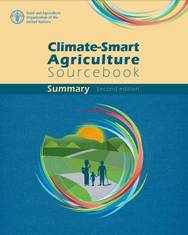Significant developments

This booklet presents a summary of the contents of the second edition of the Climate-Smart Agriculture Sourcebook. The landscape of international climate action has changed considerably since FAO introduced the concept of climate-smart agriculture (CSA) at the Hague Conference on Agriculture, Food Security and Climate Change in 2010, and followed up later with the publication of the first edition of the CSA Sourcebook in 2013. Most importantly, in 2015 the international community adopted the 2030 Agenda for Sustainable Development, which encompasses the Paris Agreement on Climate Change, the Sustainable Development Goals (SDGs) and the Addis Ababa Action Agenda, and provides an unprecedented international framework for increasing the effectiveness of national actions and collective international efforts to achieve sustainable development.
In order to implement the 2030 Agenda, FAO has developed a common vision for sustainable food and agriculture (SFA). FAO understands agriculture to comprise crops, livestock, fisheries and aquaculture and forestry. This vision is based on five principles that balance social, economic and environmental considerations and provide a framework for developing appropriate policies, strategies, regulations and incentives. To address the specific challenges climate change poses to sustainable food and agriculture, FAO promotes climate-smart agriculture (CSA) as an approach that can transform and reorient agricultural systems to effectively support development and ensure food security in a changing climate.
In this new international landscape, the three interlinked objectives of CSA are more relevant than ever. SDG2 integrates the promotion of sustainable agriculture into its overarching goal to end hunger, achieve food security and improve nutrition by 2030. This is a clear recognition that the world's agricultural ecosystems will not be able to deliver the 50 percent increase in productivity needed by 2050 to feed the growing world population, if current unsustainable natural resource management practices are maintained. The impacts of climate change on agriculture undermine the food security and livelihoods of the world's most vulnerable people and threaten Earth’s most vulnerable ecosystems. Action on closely related objectives, such as clean water and sanitation (SDG6), sustainable consumption and production (SDG12), life below water (SDG14) and life on land (SDG15) must be mobilized in tandem, to meet SDG13’s targets on combatting climate change and its impacts.

